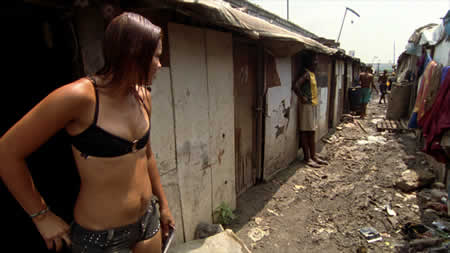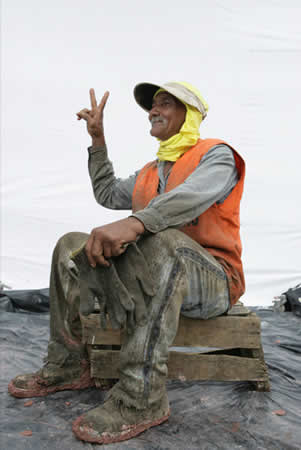 Filmed over nearly three years, Wasteland follows renowned artist Vik Muniz as he journeys from his home base in Brooklyn to his native Brazil and the world’s largest garbage dump, Jardim Gramacho, located on the outskirts of Rio de Janeiro. There he photographs an eclectic band of “catadores”—self-designated pickers of recyclable materials. Muniz’s initial objective was to “paint” the catadores with garbage. However, his collaboration with these inspiring characters as they recreate photographic images of themselves out of garbage reveals both the dignity and despair of the catadores as they begin to re-imagine their lives. Director Lucy Walker (Devil’s Playground, Blindsight, Countdown To Zero) has great access to the entire process and, in the end, offers stirring evidence of the transformative power of art and the alchemy of the human spirit.
Filmed over nearly three years, Wasteland follows renowned artist Vik Muniz as he journeys from his home base in Brooklyn to his native Brazil and the world’s largest garbage dump, Jardim Gramacho, located on the outskirts of Rio de Janeiro. There he photographs an eclectic band of “catadores”—self-designated pickers of recyclable materials. Muniz’s initial objective was to “paint” the catadores with garbage. However, his collaboration with these inspiring characters as they recreate photographic images of themselves out of garbage reveals both the dignity and despair of the catadores as they begin to re-imagine their lives. Director Lucy Walker (Devil’s Playground, Blindsight, Countdown To Zero) has great access to the entire process and, in the end, offers stirring evidence of the transformative power of art and the alchemy of the human spirit.
Bijan Tehrani: How did you come up with the idea of making the film Wasteland?
Lucy Walker: It came out of a conversation with an artist named Vik Muniz. I was inspired by his work and loved it visually; I love photography and I love art. I was thinking about how you might make a good documentary about his work. He had previously worked with Junk, and these were some of my favorite pieces that he had done. He had also done some social projects, so when I talked to him, I asked him more about working with street children and working people in the Caribbean. We decided that doing a big project that was also a social project would be a good film. We kept talking and I kept asking him about different projects and we noticed that both of us had an interest in garbage and he had previously worked with Junk. So we visited a landfill and  decided that it was a really interesting place for a movie and it really made me think about waste in our consumer society. It was a very sensory place that assaults your nose, your eyes and your ears. He was scared to go to a garbage dumb as a photographer because garbage dumps are places that are used to hide crimes. I said that it sounded like a very interesting project and he wanted to do it, even though he was a bit scared. We had a wonderful producer who gave us the money to start the project and the goal of the project started to come true.
decided that it was a really interesting place for a movie and it really made me think about waste in our consumer society. It was a very sensory place that assaults your nose, your eyes and your ears. He was scared to go to a garbage dumb as a photographer because garbage dumps are places that are used to hide crimes. I said that it sounded like a very interesting project and he wanted to do it, even though he was a bit scared. We had a wonderful producer who gave us the money to start the project and the goal of the project started to come true.
BT: How challenging was it to make this film?
LW: It was very scary and I was very nervous. I had so many vaccinations and, the way I was covered, it looked like I was going to the moon. The good thing was that the crew and the people who worked in the landfill were amazing and so easy to work with, so that really helped. It was big surprise that the people that worked there were some of the coolest people that I had ever met and I ha no idea that they were doing such a great job for the environment in a place that is very disgusting for the rest of us. There was something mythical about in the way that they are salvaging our waste for us and its weird to think that people who work with garbage can be such redeemers.
BT: How was your relationship with the residents there?
LW: They were great people and worked really well with the crew. There were so many things about this project that were fortuitous and that went really well, and our relationship with the residents was one of them.
BT: How did you come up with the visual style of the film?
LW: I think that the visual style is very much the style that I like, which is getting as many beautiful shots that you can with the best cinematographer and the best equipment that you can use. We received money from the Brazilian government and were allowed to shoot the best possible film images. The surprise was that I did not know what music I was going to use. The music in the end that I chose was not Brazilian. In the editing, we found this great electronic score and it was very effective and very universal and cinematic music. The style of the film is very much like my previous films and possibly makes for a documentary.
 BT: What was the initial reaction to the film?
BT: What was the initial reaction to the film?
LW: It’s very important for the local people, and already the laws in Brazil have changed and encouraged people to recycle more. It is important for the workers because it highlights their work and shows how great they are as individuals.
BT: How do you think that this film will help environmental issues?
LM: I think that you learn a lot about recycling and it makes you think a lot about waste and consumption. The film is an emotional journey with a beginning, middle and end that I, as a filmmaker, am very proud of. It can’t help but make you more conscious and you will never be the same afterwards.
BT: What will be your next project?
LM: Right now, I am really not sure— I am still quite busy with this one so I’m not sure yet. I am considering a lot of different things, but this one will be hard to top!

